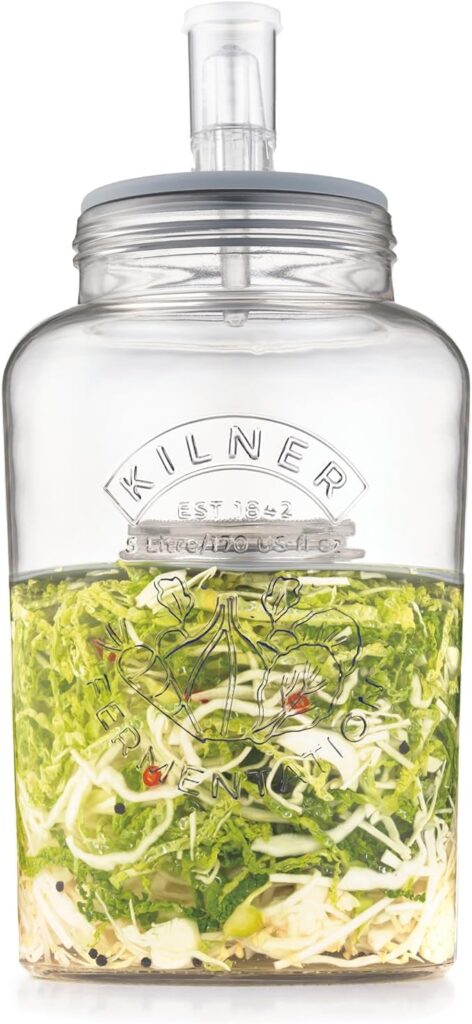What is Sauerkraut?
Sauerkraut is like the rockstar of fermented foods. It’s that tangy, crunchy, and utterly delicious mix of shredded cabbage that’s been transformed by the magic of fermentation. Imagine cabbage getting a makeover into something zesty and addictive.
Why Make Sauerkraut at Home?
Let me tell you a little secret: homemade sauerkraut is a game-changer. Not only does it taste fresher and more vibrant than the store-bought stuff, but it’s also packed with gut-friendly probiotics that can do wonders for your digestive health. Plus, it’s ridiculously easy to make at home – like, easier than whipping up a bowl of cereal.
What Are the Ingredients Needed to Make Sauerkraut?

1. Cabbage
You can’t have sauerkraut without cabbage. Opt for a nice, firm head of cabbage, green or red; it’s your call. Just make sure it’s fresh and crisp, like it’s ready to take on the world.
2. Salt
Salt is the unsung hero here. It not only adds flavor but also helps to draw out moisture from the cabbage, creating the perfect environment for those friendly bacteria to work their magic.
3. Optional Flavorings
Feeling fancy? Throw in some optional flavorings like caraway seeds, garlic, or even juniper berries. Get creative and let your taste buds be your guide.
What Equipment Do You Need to Make Sauerkraut?

1. Fermentation Vessel
You’ll need something to ferment your cabbage in; a glass jar, a ceramic crock, or even a food-grade plastic container will do the trick.
2. Weights
To keep your cabbage submerged in its own juices, you’ll need weights; think clean rocks, glass weights, or even a smaller jar filled with water.
3. Cheesecloth or Airlock
To keep any unwanted visitors (we’re looking at you, fruit flies) out of your fermenting kraut, cover your vessel with cheesecloth or use an airlock lid.
How to Make Sauerkraut at Home?
1. Prepare the Cabbage
Start by shredding your cabbage into thin strips, like you’re making coleslaw. Remove any tough outer leaves and set them aside; you’ll need them later.
2. Mix in Salt and Optional Flavorings
In a big bowl, toss your shredded cabbage with salt and any optional flavorings you fancy. Massage everything together like you’re giving your cabbage a spa day; this helps to break down the cabbage and release its juices.
3. Pack the Mixture into a Fermentation Vessel
Once your cabbage is nice and juicy, pack it tightly into your fermentation vessel. Use those reserved cabbage leaves to create a little cabbage blanket on top; this will help keep everything submerged.
4. Add Weights and Cover
Place your weights on top of the cabbage blanket to keep everything nice and snug. Cover your vessel with cheesecloth or attach the airlock lid – we’re all about keeping it safe and sound.
5. Ferment the Sauerkraut
Now comes the hard part – waiting. Let your sauerkraut ferment at room temperature for about 1 to 4 weeks, depending on how tangy you like it. Give it a taste test along the way – you’re the boss of your kraut.
How Long Does It Take to Make Sauerkraut?
Fermentation Time
Fermentation time can vary depending on factors like room temperature and personal preference. Generally, you’ll start to see some krauty action happening within a week, but feel free to let it hang out for longer if you’re feeling patient.
Storage Time
Once your sauerkraut reaches peak tanginess, transfer it to the fridge to slow down the fermentation process. It’ll keep for months – if it lasts that long without getting devoured.
How to Store Homemade Sauerkraut?
Keep your homemade sauerkraut stored in the fridge, where it’ll stay crisp and crunchy for months on end. Just make sure to use clean utensils when digging in; nobody likes a funky batch of kraut.
Conclusion
Making sauerkraut at home is not just about creating a tasty condiment; it’s a journey of flavors, textures, and beneficial bacteria. With just a few simple ingredients and some patience, you can transform humble cabbage into a crunchy, tangy delight that will elevate your meals and your gut health.
By embracing the art of fermentation, you’re not only tapping into centuries-old culinary traditions but also taking control of what goes into your food. Homemade sauerkraut is a testament to the power of simplicity, reminding us that some of the most extraordinary flavors can come from the most humble beginnings.
So, roll up your sleeves, grab a cabbage, and dive into the wonderful world of homemade sauerkraut. Your taste buds and your gut will thank you for it. Cheers to crunchy bites and happy bellies!
FAQs About Homemade Sauerkraut
Can I use any type of cabbage to make sauerkraut?
Absolutely! While green cabbage is the most common choice, you can experiment with red cabbage or even a mix of different varieties for added color and flavor.
How much salt should I use to make sauerkraut?
As a general rule, you’ll want to use about 1-3 tablespoons of salt per 5 pounds of cabbage. Adjust according to your taste preferences, but remember, the salt helps with fermentation and flavor development.
Can I add other vegetables or fruits to my sauerkraut?
Definitely! Get creative with your sauerkraut by adding carrots, onions, apples, or even jalapeños for a spicy kick. Just keep in mind that certain fruits and veggies may affect the fermentation process, so it’s best to experiment in small batches.
How do I know if my sauerkraut is fermenting properly?
During fermentation, you may notice bubbles forming and a slightly sour aroma developing. Taste your sauerkraut periodically; it should become tangier over time. If you see any signs of mold or if it smells off, it’s best to discard it and start over.
Can I use metal containers for fermenting sauerkraut?
It’s generally recommended to avoid metal containers for fermentation, as certain metals can react with the acids produced during fermentation. Stick to glass, ceramic, or food-grade plastic containers instead.
How long can I store homemade sauerkraut?
Properly stored in the refrigerator, homemade sauerkraut can last for several months, if not longer. Just make sure to keep it submerged in its brine and use clean utensils when serving to prevent contamination.
Can I freeze sauerkraut?
While sauerkraut can technically be frozen, its texture may change slightly upon thawing, becoming softer than when fresh. It’s best enjoyed fresh or stored in the refrigerator for long-term preservation.

